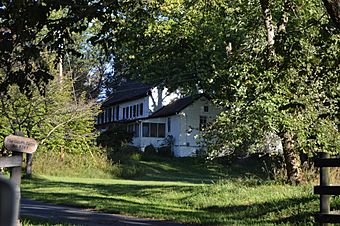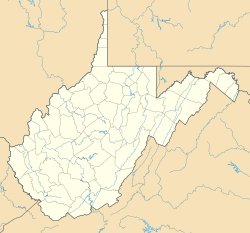William Grubb Farm facts for kids
Quick facts for kids |
|
|
William Grubb Farm
|
|

Driveway view
|
|
| Location | Jefferson County, West Virginia, USA |
|---|---|
| Architectural style | Georgian |
| NRHP reference No. | 91001735 |
| Added to NRHP | November 21, 1991 |
The William Grubb Farm is a historic place also known as Conway or Brook Manor. It is located near Charles Town, West Virginia. The main house was built around 1763 by William Grubb Jr. It has a special design called a "stone-ender." This means the ends of the house are made of stone, while the long sides were built with logs. These log sides are now covered with wooden boards called clapboards.
The farm also includes other old buildings. There is a well (built around 1920), a corn crib (from about 1850), and a barn (also from about 1850). You can also find a Quaker burial ground on the property, which has been used since 1759.
The Farm's Beginnings
In 1734, two brothers, Emanuel Grubb and John Grubb, Jr., had land measured near Bullskin Creek. This land was about 730 acres (2.95 square kilometers). Even though they probably didn't visit the area, their sons, John and William, secured the land title the next year.
Later, Emanuel's sons, including John, James, and Benjamin, moved to this area. They sent animal hides back to their family's leather business in Delaware. Over time, the family bought more land, adding another 920 acres (3.72 square kilometers) to their property.
Life on the Frontier
The area was a wild frontier back then. Living there was tough and sometimes dangerous. Benjamin Grubb was one of the last family members to live there from Emanuel's side. He eventually sold his share of the land and moved away in 1864.
When John Grubb, Jr. passed away in 1758, his son Adam inherited his part of the land. Adam was a shipbuilder in Pennsylvania and didn't need the farm. So, he leased it to his older brother, William Grubb (1713–1775). William was a farmer from Delaware and a leader in the Quaker church. The Quakers were interested in starting a community near Charles Town. In 1762, William and his brother Samuel received even more land from Lord Fairfax.
Building the Farmhouse
After a war ended, it became safer to settle in the region. William's son, William Grubb, Jr. (1740 - around 1810), moved to the farm from Delaware with his new wife, Susanna. They eventually inherited all the family's land along Bullskin Creek. They raised eight children there.
During the American Revolution, William Grubb, Jr. helped his neighbor, George Washington. He supplied over 100 barrels of whiskey each month! By 1800, a mill was built on the property, which worked until 1935. There was also a Quaker Meeting House on the farm, but it no longer exists.
When William Grubb, Jr. died, his son William Grubb III inherited the property. However, William III moved to Ohio in 1814. He sold the farm to his sister Rebecca and her husband, John Haines. The house was made bigger in 1880 by Warren Eby.



